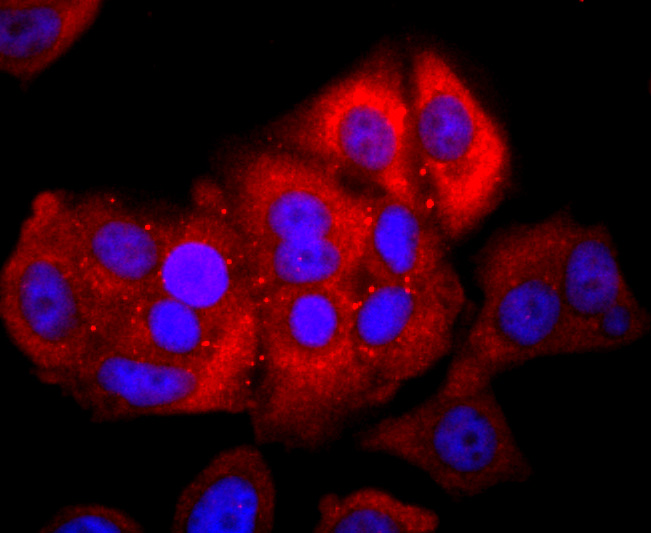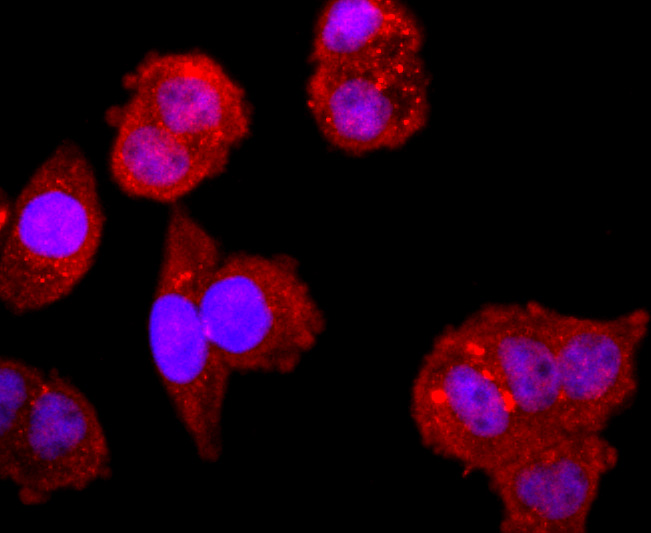Product Name :
NFAT1 polyclonal antibody Background :
The NFAT (nuclear factor of activated T cells) family of transcription factors regulates cytokine expression in T cells. Members of the family include NFATc1 (NFATc), NFATc2 (NFATp), NFATn, NFATc3 (NFAT4, NFATx) and NFATc4 (NFAT3). Recognition of antigen by the T cell receptor (TCR) eventually activates the calcium-dependent protein phosphatase calcineurin. Once activated, calcineurin stimulates the translocation of NFATc1 (cytoplasmic) from the cytoplasm to the nucleus where it associates with NFATn (nuclear). Like NFATc1, NFATc2 resides in the cytoplasm and translocates to the nucleus subsequent to activation of calcineurin. Once in the nucleus, NFATc2 synergizes with AP-1 transcription factors to initiate transcription of cytokine genes. NFATc3 and NFATc4 share 65% sequence identity with other members of the NFAT family. They are similar to NFATc2 in that they also synergize with the AP-1 family of proteins. Product :
Rabbit IgG, 1mg/ml in PBS with 0.02% sodium azide, 50% glycerol, pH7.2 Storage&Stability :
Store at +4°C after thawing. Aliquot store at -20°C or -80°C. Avoid repeated freeze / thaw cycles. Specificity :
NFAT1 polyclonal antibody detects endogenous levels of NFAT1 protein. Immunogen :
recombinant protein Conjugate :
Unconjugated Modification :
Unmodification
NFAT1 polyclonal antibody Background :
The NFAT (nuclear factor of activated T cells) family of transcription factors regulates cytokine expression in T cells. Members of the family include NFATc1 (NFATc), NFATc2 (NFATp), NFATn, NFATc3 (NFAT4, NFATx) and NFATc4 (NFAT3). Recognition of antigen by the T cell receptor (TCR) eventually activates the calcium-dependent protein phosphatase calcineurin. Once activated, calcineurin stimulates the translocation of NFATc1 (cytoplasmic) from the cytoplasm to the nucleus where it associates with NFATn (nuclear). Like NFATc1, NFATc2 resides in the cytoplasm and translocates to the nucleus subsequent to activation of calcineurin. Once in the nucleus, NFATc2 synergizes with AP-1 transcription factors to initiate transcription of cytokine genes. NFATc3 and NFATc4 share 65% sequence identity with other members of the NFAT family. They are similar to NFATc2 in that they also synergize with the AP-1 family of proteins. Product :
Rabbit IgG, 1mg/ml in PBS with 0.02% sodium azide, 50% glycerol, pH7.2 Storage&Stability :
Store at +4°C after thawing. Aliquot store at -20°C or -80°C. Avoid repeated freeze / thaw cycles. Specificity :
NFAT1 polyclonal antibody detects endogenous levels of NFAT1 protein. Immunogen :
recombinant protein Conjugate :
Unconjugated Modification :
Unmodification
-
 ICC staining NFAT1 in MCF-7 cells (red). The nuclear counter stain is DAPI (blue). Cells were fixed in paraformaldehyde, permeabilised with 0.25% Triton X100/PBS.
ICC staining NFAT1 in MCF-7 cells (red). The nuclear counter stain is DAPI (blue). Cells were fixed in paraformaldehyde, permeabilised with 0.25% Triton X100/PBS. -
 ICC staining NFAT1 in Hela cells (red). The nuclear counter stain is DAPI (blue). Cells were fixed in paraformaldehyde, permeabilised with 0.25% Triton X100/PBS.
ICC staining NFAT1 in Hela cells (red). The nuclear counter stain is DAPI (blue). Cells were fixed in paraformaldehyde, permeabilised with 0.25% Triton X100/PBS.
Bioworld Biotech only provide peptides for our antibodies and do not provide additional peptide customization services.
Price/Size :
USD 368/1mg/vial
Tips:
For phospho antibody, we provide phospho peptide(0.5mg) and non-phospho peptide(0.5mg).Describe :
Blocking peptides are peptides that bind specifically to the target antibody and block antibody binding. These peptide usually contains the epitope recognized by the antibody. Antibodies bound to the blocking peptide no longer bind to the epitope on the target protein. This mechanism is useful when non-specific binding is an issue, for example, in Western blotting (WB) and Immunohistochemistry (IHC). By comparing the staining from the blocked antibody versus the antibody alone, one can see which staining is specific; Specific binding will be absent from the western blot or IHC performed with the neutralized antibody.Formula:
Synthetic peptide was lyophilized with 100% acetonitrile and is supplied as a powder. Reconstitute with 0.1 ml DI water for a final concentration of 10 mg/ml.The purity is >90%,tested by HPLC and MS.
Storage:
The freeze-dried powder is more stable. For short time at 2-8°C. For long term storage store at -20°C.
Note :
This product is for research use only (RUO only). Not for use in diagnostic or therapeutic procedures.
 NFAT1 polyclonal antibody
NFAT1 polyclonal antibody  Datasheet
Datasheet COA
COA MSDS
MSDS SHIP
SHIP